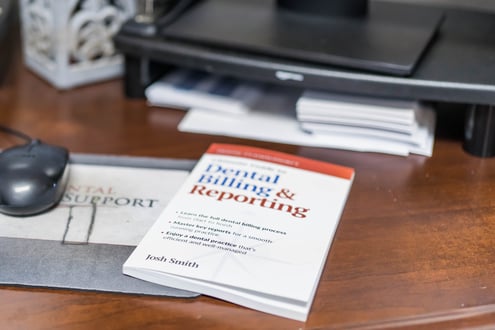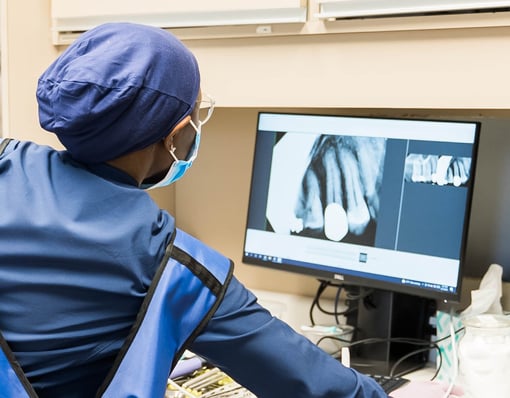6 common myths about submitting dental insurance claims


One of the easiest mistakes to make in the dental claims processing world is to assume. You might expect the path from insurance claim to bank deposit is straightforward, but complex systems don’t always work like you’d expect, and the claims process is no different.
It can be hard to understand how to collect from insurance claims successfully unless you can differentiate truth from myth about the way dental insurance claims actually work.
At Dental ClaimSupport, we see dental practices believe these myths too often, and in turn, miss out on revenue they could be collecting. This is why we’ve spent years trying to understand these insurance claims myths so that we could, well… bust them!
In this article, you will learn the 6 most common myths about dental insurance claims, and the truth behind them. Understanding these myths can help you more accurately navigate the ever-so-confusing world of dental insurance. Properly submitting claims will help your practice collect the money it has earned from insurance companies in a more timely manner.
Myth #1: All dental claim submissions make it to the insurance company
If only this were true... there are a number of reasons dental claims don’t make it to that final destination. It could be a technical problem, it could be that the claim wasn’t properly batched. It’s easy to think that once you submit your claim, you can check it off your list and not worry about it until it’s paid.
The truth: A rough estimate is that 1/3 of the claims sent never get to the insurance company the first time
Insurance verification, data entry, and Payer IDs all play major roles in making sure your claim makes a swift journey to the insurance company to get processed and paid. In other words, all you can do is make sure you’re properly verifying insurance and accurately inputting the patient’s information for the claim, while also following up on its status.

Myth #2: If most of the information is correct, then the claim will get to the insurance company
It’s tempting to hope that “close enough” is good enough. That’s not the case with insurance claims. ALL of the information needs to be correct on the claim. The clearinghouse may catch any inaccuracies before it sends the claim to the insurance company, and in the event your claim does make it through, insurance companies will find any reason to deny your claim.
If you are not using a clearinghouse or do not know which clearinghouse you are using, you should find a clearinghouse ASAP, and you should be working in the clearinghouse daily.
The truth: Correct data entry is the golden ticket to paid claims
Inaccuracies and incomplete information are sure-fire ways to have your claim immediately denied. There’s no argument that the day-to-day at the front desk can get hectic and work gets rushed, but taking the time to enter the patient’s information into the software correctly the first time is one of the single most important things you can do to ensure your claim is paid without delay.
Myth #3: Once I batch a claim, it will be submitted
Batched claims are essentially dental claims that are in line to be sent to the insurance company. Just because a claim has been batched doesn’t mean it has been sent to insurance to be paid. A big reason people believe a batched claim is a sent claim is simply because they haven’t been told otherwise.
The truth: You have to send the claim to the clearinghouse after it’s batched
Once a claim is batched, it manually needs to be exported to a clearinghouse that will then send it to the insurance company. Batched does not mean sent. Let me reiterate that you should definitely be using a clearinghouse to send your claims.
Creating vs batching vs sending a claim: what’s the difference? Find out in our Learning Center.
Myth #4: Claims go from my office to the insurance company directly
We all wish it was this simple. You might think that once you file a claim, it goes to the insurance company directly. But you really don’t want to be responsible for keeping track of which claims go to which insurance companies for hundreds of procedures you do every month.
Instead, there are a few steps in between when you send your claim and the insurance company receives it. You need them to streamline the process.
.jpg?width=433&name=DSC05563%20(1).jpg)
The truth: After you create, batch, and send your claim, it goes to the clearinghouse
Once you batch your insurance claims in your software and manually export them, the claims then do not go directly to the insurance company. They first go to your clearinghouse. A clearinghouse is a middleman between your office and insurance companies. Can you tell we feel strongly about clearinghouses?
It’s an important distinction because your clearinghouse is what makes electronic claims work so efficiently. They are the one-stop-shop that aggregates all your data, scrubs all the information for inaccuracies, and most importantly ensures your claims are flagged for needed correction, or go securely to the insurance companies when they’re ready.
Your clearinghouse makes your life a lot easier than it would be without them.
Myth #5: Clearinghouses automatically know where to send my claim once it’s received
Because a clearinghouse is a middleman between the practice and the insurance, you might think the clearinghouse would be automated enough to take care of your claim for you. However, that’s not really how they work.
The truth: Clearinghouses are wonderful, yes, but they aren’t all-knowing
The clearinghouse relies on what’s called a Payer ID to filter and forward the claim to the correct insurance company. Payer IDs have 5 characters which may be numbers, letters or alphanumeric, and are unique to each insurance company.
If you have the wrong Payer ID entered in your dental software for an insurance company, the electronic claim will not get there.
Moral of this myth? Don’t rely on anyone but yourself (or your outsourced dental billing company) to ensure your claims reach the insurance company and are paid. Accurate data entry is the biggest determining factor of your claims being denied. Triple-check your entries!
Myth #6: Attachments for major and basic services are automatically included with claims
Last but not least: don’t ever assume ANYTHING is automatic when it comes to claims.
Dental software does an amazing job of organizing and maintaining all the information you collect on your patients and your claims. So, it’s common to get the mistaken impression that any necessary attachments are automatically included with the claim.
The truth: The dental team is responsible for making sure attachments are included in the claim
It’s up to the administrative team or billing company to pull data from the software when claims (usually major and some basic services) need supporting evidence in order to be approved. Usually these include major and some basic services. Supporting documentation comes in the form of attachments like x-rays, periodontal charting, chart notes, or narratives.

Avoid these mistakes and get your dental insurance claims paid
Getting claims paid involves extensive knowledge about tiny but essential details that sometimes get lost in the mix. Keeping up-to-date and continually informed about dental insurance, federal and state regulations, and the facts about how the dental claims process works is the best way to ensure you collect as much as possible for everything you produce.
Denials lead to payment delays from insurance, and the longer the delays are, the less likely the claims are going to be paid.
Don’t keep making the same mistakes when it comes to submitting claims, and too many people end up writing off shortfalls instead of requesting the payment their team has earned. Everyone in your dental practice deserves to be paid fully for their work. Learn how to appeal claims effectively by reading our article, “How to win dental insurance appeals: 5 simple tips.”
Related Posts
Dental revenue resources from Dental Claim Support

